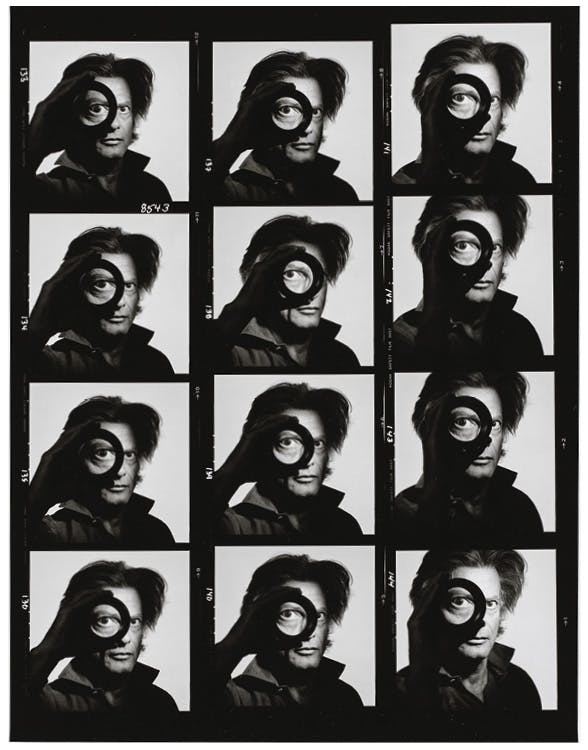
PROOF: Photography in the Era of the Contact Sheet
- Magazine Article
- Exhibitions
Contact sheets provide a glimpse of the photographer at work

Richard Avedon New York, 1985. Irving Penn (American, 1917–2009). Gelatin silver print; 27.9 x 21.6 cm. © The Irving Penn Foundation
Born in 1898, Alfred Eisenstaedt began his photographic career in Berlin in the late 1920s, just as photographs were beginning to flood the pages of magazines and newspapers. Thirty years later he was a celebrated staff photographer at Life magazine when he explained why roll film had become so important:
"The greatest disadvantage of the cameras I was using in 1929 and 1930 was the time lost between shots. Even the Ermanox, with its relatively fast lens, was a one-shot camera, and the heavy metal holders and glass plates were an unbelievable nuisance.
The answer was the Leica, the first 35mm still camera. Not only did it have a fast lens, it let you take 36 exposures without reloading. . . ."

The Leica was designed in the mid-1920s to make still photographs on 35mm motion-picture film. After the film was developed, the negatives were cut into strips, arranged on a sheet of photographic paper, and held flat under a piece of glass. The resulting proof print, or contact sheet, was the photographer’s first opportunity to see a positive image of each exposure and to choose which frame or frames to enlarge. There were two standard formats, both of which fit neatly on a sheet of 8 x 10 inch paper: the 36 rectangular frames of 35mm film and the 12 square frames of 120 film. Contact sheets were indispensable and ubiquitous throughout the second half of the 20th century—until digital technology rendered roll film obsolete.
The late collector Mark Schwartz worked with photography every day as creative director of the award-winning Cleveland graphic design firm Nesnadny + Schwartz. That intimate familiarity with the medium surely contributed to his enthusiasm for contact sheets. They figure prominently in the wide-ranging photography collection that he and his wife, Bettina Katz, began to build more than two decades ago and which now forms the basis of the exhibition PROOF: Photography in the Era of the Contact Sheet. No doubt Schwartz’s relentless passion, for his personal as well as professional pursuits, was also a critical factor, because assembling a collection of contact sheets was nearly as challenging as it was improbable.
The challenge was that contact sheets were not typically exhibited or offered for sale. Photojournalist Elliott Erwitt insisted that they “should be as private as a toothbrush . . . guarded as jealously as a mistress.” And that intimacy—the chance to get a glimpse of the photographer at work—is precisely why contact sheets can be so fascinating and instructive. A sheet by Schwartz’s friend Larry Fink, for example, allows us not only to follow the photographer at a gala to benefit New York’s Museum of Modern Art but also to see which frames he chose to enlarge and crop.
The sheet shows us that Fink focused on couples or small groups of people as he moved around the party. The range of options was usually narrower still in the controlled setting of a professional studio, where the photographer generally decided on the basic elements of the picture before making the first exposure. For example, when Irving Penn set out to make a portrait of fellow photographer Richard Avedon in 1985—by which time the two had been colleagues and rivals for nearly 40 years—he focused a spotlight on Avedon’s face and introduced the prop of the lens to intensify the gaze of the photographer’s right eye. Subtle variations of a carefully crafted composition are typical of Penn’s contact sheets: traces of the master’s relentless pursuit of perfection.
The Avedon sitting might have generated as many as 10 rolls of film, or 120 frames. This single sheet (opposite page, one of 22 works by Penn in the exhibition) does not include the frame that Penn eventually chose, but it possesses the special vitality of a grid of images, all similar to each other, each different. That vitality led a number of photographers, including Penn, to occasionally present the gridded array of a contact sheet as an aesthetic whole. Consequently, the prints on display range from working documents that were never intended to be seen by the public (and which therefore can offer privileged insight into the photographer’s strategies and methods) to independent, fully realized works of art (which sometimes nevertheless exploit the flair of uncensored improvisation).

The last section of the exhibition is devoted to the latter, and it includes six works from the collection of the Cleveland Museum of Art that help to suggest how the spirit of the contact sheet nourished the art of photography more broadly. One of these works (above) was made by Schwartz in 1979 and exemplifies the splendid, generative role that collections play in the life of museums.
The better a photograph is, the less likely we viewers are to consider how it might have been different. This is photography’s most powerful trick: what is in fact just one out of millions of possibilities is accepted as inevitable. Contact sheets pull back the curtain just enough for us to get a sense of how these infinitely seductive fictions are made.